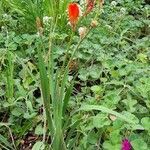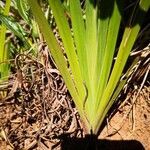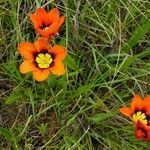Herb 10–30 cm high. Corm 1–2 cm diam. Leaves 5–10, linear to oblanceolate, acute, 8–20 cm long, 5–15 (–18) mm wide. Scape unbranched. Spike flexuose, 2–6-flowered. Bracts lanceolate, acute, shallowly lacerate, 2.3–2.8 cm long. Flowers broadly funnel-shaped. Perianth tube c. 8 mm long, narrow at base, widened above, bright yellow; lobes oblanceolate to lanceolate, 2.5–3 cm long, c. 1 cm wide, orange to dark red with black sagittate mark at base. Stamens equilateral; filaments 6–7 mm long; anthers erect, c. 8 mm long, yellow. Style erect, not exceeding anthers; branches cuneate, 1–2 mm long, yellow. Fruit not seen. Bulbils few, in lower leaf axils only. [This description from Cooke (1986a: 56) requires revision, it possibly includes elements of Sparaxis pillansii L.Bolus, as material from Western Australia, e.g. specimen Royce 4371 (PERTH), was included in the S. tricolor treatment -Editor, 29 September 2020.]
Plants 10–40 cm. Corms tunicate; tunic with fine, whitish fibers. Leaves several, ± reaching base of spike. Spikes: spathes pale brown with darker brown streaks, subequal, dry, crinkled, outer with entire or lightly lacerate margins, inner forked apically. Tepals bright orange, yellow in center, with heart-shaped yellow mark in proximal 1/3, outlined distally with dark reddish brown band, lanceolate, subequal, 25–33 mm; perianth tube funnel-shaped, ca. 8 mm; stamens symmetrical; filaments contiguous, 6–7 mm; anthers yellow, linear, 8–9 mm; style slender, branching opposite anthers; branches 1–2 mm, expanded apically.
Tufted, grass-like, to 20 cm high. Corm c. 2 × 1.5-2 cm; tunic grey-brown, closely woven. Leaves to 20 × 0.6-1 cm reaching to c. level of lowest flowers in basal fan; cormils few in lowermost leaf-axils. Inflorescence a spike; spathe-valves 2-3 cm long, marked with minute red-brown flecks, entire or lacerate at tip. Flowers (1)-2-5, ± 4 cm long, 4-5 cm diam.; tube c. 1 cm long, enclosed by spathe-valves; lobes variously coloured from deep orange-red through scarlet-red to dark purple-red, internally all with a dark brown blotch above bright yellow tube. Stamens symmetrical. Capsule not seen.
Cormous geophyte to 30 cm. Leaves lanceolate. Flowers actinomorphic, stamens and style central, orange with black and yellow centres.





